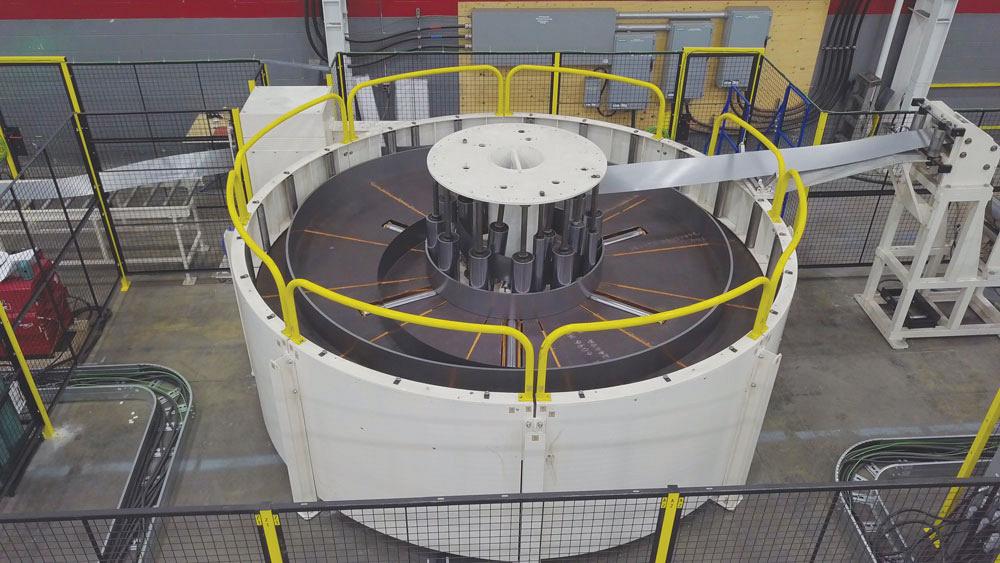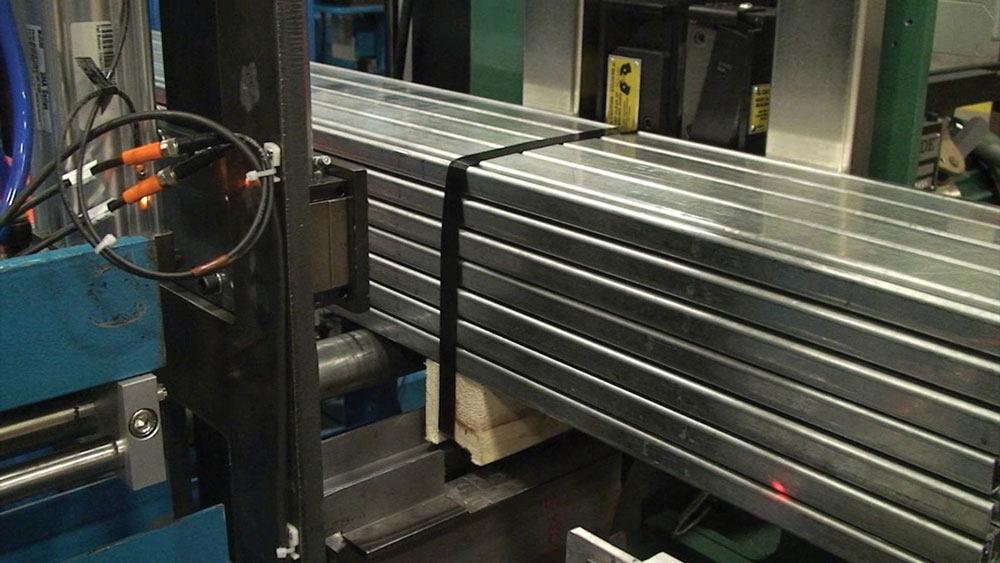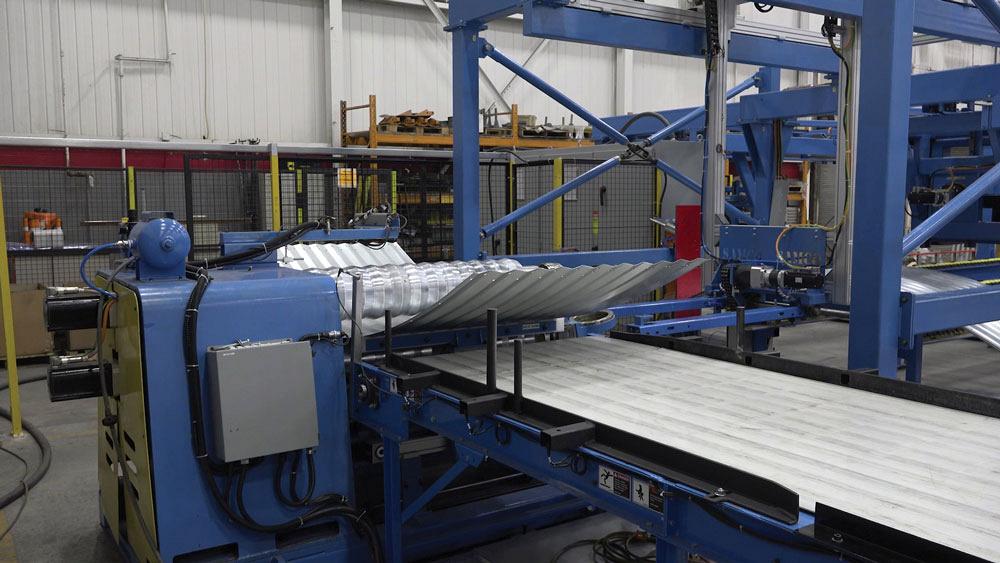vice-president of applications engineering
- FMA
- The Fabricator
- FABTECH
- Canadian Metalworking
Monitoring your roll forming setup
Optimizing your roll forming system using feedback mechanisms and integrated secondary equipment ensures process accuracy
- By Jaswinder Bhatti
- May 11, 2023
- Article
- Automation and Software
Your business success depends on the quality of the end product coming off your roll forming systems. Inspection systems can be implemented on various segments of a complete line, not just a roll former.
The creation of a sophisticated, fully automated roll forming operation also demands that you monitor processes to ensure results remain consistent. The automation of the roll forming process, from coil handling to packaging, demands the same attention to detail. There are a variety of places in the roll forming process where efficiency can help to ensure consistent quality of parts and improve uptime. Choosing the right tools to monitor the accuracy of that line is also key.
Front-end Systems
The speed at which metal enters the front end of your roll former has an obvious effect on the efficiency of the roll forming system. Accumulators are a great way to keep your roll former running. Coil coming off the uncoiler goes into the end shear welder and then into the accumulator, where it is then fed into the next in-line process. When the entire coil is fed into the accumulator, the next coil can be joined with the end shear welder without stopping the roll forming process. Once the new coil has been welded, it runs the new material into the accumulator. Traditionally, tube mills were the only process that used the accumulators but now it can be added to any roll forming system.
To make sure a process is going to run properly, it’s important to verify the materials. Even if the coil is being managed by an operator, it’s useful to have independent verification by automated feedback systems.
It’s also possible to monitor the coil OD and make the decisions based on the material left at the end of the coil. For instance, if 40-ft.-long parts are necessary for a particular product and the end of the roll is left with 39 ft. of material, then that can’t be used for the part. Left unmonitored, you could be left with 39 ft. of scrap. However, you can make usable shorter parts by employing an automated monitoring system. Monitoring the coil roll, hence, adds flexibility to the automation process.
The monitoring system also can be used to validate the thickness and width of the material and to compare it with the programmed part data. If the wrong material thickness or width is used, it can signal the machine to stop.
In-line Options
Integrating equipment in the middle of your line is another possibility. Adding other processes in-line such as high-frequency welding systems and spot welding systems can help make the line more efficient. Like any welding system, feedback mechanisms are available to ensure welds are accurate.
Coil-end joiner welds can be traced and monitored, and parts can be scrapped out. The system can also monitor part presentation, i.e., ensuring that the two ends are properly aligned before starting the weld for accurate bead placement.
It also is possible to integrate other tests during roll forming to ensure accuracy.
For instance, a test could be integrated to check punched holes for dimensional accuracy or to determine that the correct number of holes have been punched.

The speed at which metal enters the front end of your roll former has an obvious effect on the efficiency of the roll forming system. Accumulators are a great way to keep your roll former running.
The choice between using a vision system or a laser checking system will depend on the complexity of the punching pattern, the configuration of the holes, the speed of the material passing through, and any other information available.
In some cases, it is required for the material to be curved in-line to a certain size. However, while in-process, if the bend radii of a part is found to be too big or small, the software takes that feedback and automatically adjusts the settings on the curving unit to correct the discrepancy.
Back-end Options
When the roll forming process is completed, what happens to your finished product? Various material handling systems can be integrated at the end of the roll forming line to improve efficiency. Samco offers a variety of options including bundlers, stackers, and pick-and-place units.
The product can be strapped or shrink-wrapped for packaging. Protective sheets can be placed on the top or bottom of packages. Dunnage can be added to the bottom of packages so they can be easily moved by robotic lifts that then stack packages in a safe pyramid for shipping.
Of course, it’s necessary to ensure that any damaged or incorrect parts don’t end up packaged with quality parts at the end of the line. An in-line monitoring system is effective in ejecting damaged or incorrect the parts away from final packaging if necessary.
Technology is available to measure part profiles, hole locations, hole presence, and parts lengths, among other measurements. If the part is not according to the specifications, it can then be scrapped accordingly.
Floor Setup
While monitoring technology can be a valuable addition to any roll forming system, retrofitting an already established system is not necessarily a simple proposition. If you are hoping to add feedback mechanisms and in-line process systems to an existing system, it’s important to consider your shop floor real estate and how it can best work for you. Remember that in many cases automation requires more real estate than a manual operation.
The latest and greatest automated material handling systems can make any manufacturer’s life easier. Automation has become necessary not only to help manage high production without an increase in labour costs, but also to help create a safer work environment. With the right automation setups at the front end, in-line, and in packaging, the efficiency of your roll forming systems will be increased substantially.
Jaswinder Bhatti is vice-president of applications engineering for Samco Machinery, 351 Passmore Ave., Toronto, Ont. M1V 3N8, 416-285-0691, www.samco-machinery.com.

There are many packaging options, such as strapping and shrink-wrapping, that can be added to a roll forming production line. It’s necessary to ensure that any damaged or incorrect parts don’t end up packaged with quality parts at the end of the line. An in-line monitoring system is effective in ejecting the parts away from final packaging.
About the Author
subscribe now


Keep up to date with the latest news, events, and technology for all things metal from our pair of monthly magazines written specifically for Canadian manufacturers!
Start Your Free Subscription- Trending Articles
Aluminum MIG welding wire upgraded with a proprietary and patented surface treatment technology

Achieving success with mechanized plasma cutting

Hypertherm Associates partners with Rapyuta Robotics

Gema welcomes controller

Brushless copper tubing cutter adjusts to ODs up to 2-1/8 in.

- Industry Events
MME Winnipeg
- April 30, 2024
- Winnipeg, ON Canada
CTMA Economic Uncertainty: Helping You Navigate Windsor Seminar
- April 30, 2024
- Windsor, ON Canada
CTMA Economic Uncertainty: Helping You Navigate Kitchener Seminar
- May 2, 2024
- Kitchener, ON Canada
Automate 2024
- May 6 - 9, 2024
- Chicago, IL
ANCA Open House
- May 7 - 8, 2024
- Wixom, MI
















